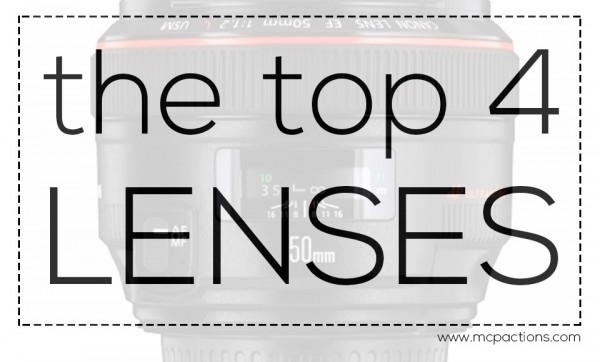
* This is a reprint of a popular article from the past that addresses one of the most asked questions on the MCP Facebook Group: “what lens should I use for (insert specialty) photography?”
Of course, there is no right or wrong answer, and there are an exponential number of external factors that play into this decision: what is the space like, how much room will you have, is there enough light, and how many people in the frame, and what type of photography are you doing, just to name a few. So, we took this to MCP’s Facebook Page and asked users their favorites. The following is a very unscientific compilation of their real world experience and preferences when it relates to portrait photography. We’ll also mention a few other types of photography along the way… We aren’t addressing brand specific lenses since that would be a much longer article.
Here are our top 4 lens recommendations for portrait and wedding photographers:
50mm (1.8, 1.4, 1.2)
One of the most talked about lenses, and a great intro to primes is the 50mm 1.8 (most brands have one). A 50mm does not produce much distortion, is lightweight, and can be purchased starting around $100 or so. This means that this is a great lens for portraits, and it is used by many newborn photographers. Shot at an aperture from 2.4-3.2 will show off this lens’s sharpness and bokeh. This is a “must have” lens for both crop and full frame camera bodies. For more advanced hobbyists and professionals, they may opt for the pricier versions in 1.4 or 1.2 (not available for all manufacturers).
85mm (1.8, 1.4, 1.2)
True portrait length on a full frame. The sweet spot, or aperture that is generally most sharp, is around 2.8. This lens is a favorite among many portrait photographers because it is not too long (allowing you to maintain a close proximity to the subject) while producing a creamy and rich bokeh. Again, the 1.8 version will be least expensive, climbing to higher prices in a 1.4 or 1.2 version (when available in a specific brand).
24-70 2.8
An excellent all around lens. This is the go-to focal range for a walk-around zoom lens, or for tight, low-light, spaces indoors (yep, back to those newborn photographers). Sharp wide open, yet even sharper around 3.2, this lens is perfect for both full frame and crop sensor camera bodies. Most brands have this length, including some manufacturers like Tamron, who make them for a number of camera brands. I personally have the Tamron version of this lens.
70-200 2.8
The wedding and outdoor portrait photographers dream lens. A great low-light lens that is also fast. Sharpest from 3.2-5.6. This lens consistently produces creamy backgrounds with tack sharp focus due to image compression at longer focal lengths. I love this focal length. I have both the Canon and Tamron versions of it and they both are super sharp and amongst my favorite lenses. When at your next sporting event, look to the sidelines. Every sports photographer I know has at least one or more of these, in addition to their longer telephoto primes.
Honorable Mentions
- 14-24mm – Great for Real Estate and Landscape photography
- 100mm 2.8 – a great macro lens. Super sharp at f 5. Also good for wedding and newborn detail shots.
- 135mm f2L Canon and 105mm f2.8 Nikon – Two favorite portrait primes. Amazing results.
Deciding to purchase a new lens can be overwhelming with all of the options available. And many are confused at the cost difference from a 1.8 to 1.4 to 1.2 aperture, which can be the difference between a $100 lens and a $2000 lens! The larger the maximum aperture, the more expensive and heavier the lens becomes. This is because of the lens components needed to create sharp images while the lens and sensor are wide open. However, you do not need to spend thousands of dollars on a lens to produce a great photograph. Understanding the exposure triangle and strong composition are the most important factors in consistently producing great photographs.
Now it’s your turn. What are your favorite lenses and why?
